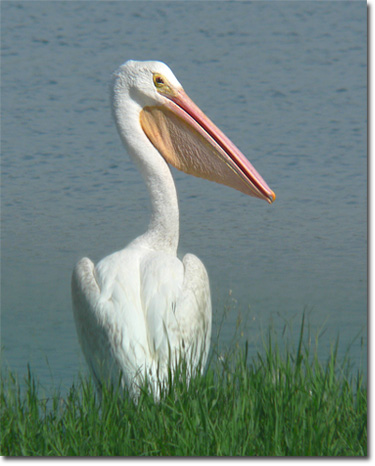
There is one bird on our lakes that really stands out this time of year—the American White Pelican (Pelicanus erythrorhynchos). If you have someone who is getting interested in birds, you could do a lot worse than to take them to Lake Overholser and look at the pelicans there. Huge, striking, simultaneously beautiful and ugly, interesting, and easily-identified birds. The wingspan of a white pelican is 9 feet, one of the largest of any North American bird. They are massive and beautiful in flight. The primary and outer secondary wing feathers are black and breeding birds have a pale yellow crest, but otherwise the bird is white. Examination of the face shows a certain ugliness or humor for its weirdness—a huge orange bill with a huge orange pouch forming the bottom of the bill; in breeding season, adults have a large hump on the top portion of the bill.
Unlike the Brown Pelican the American White Pelican does not fish by diving into the water; they scoop up water in the large pouch while floating on the surface. The birds then strain the water out of the pouch hoping they have caught a meal of fish. Often, while fishing, these pelicans form a line on the water and move forward together, which no doubt increases the odds of an individual pelican catching supper. One question is raised by Bent (1964, Life Histories of North American Petrels and Pelicans and their Allies): do the pelicans catch large fish? Bent mentions that there are only reports of small fish seen being caught, but large fish heads sometimes appear around a nest. Perhaps this question has been answered in the years since Bent published his life history of the Pelican.
Although a few white pelicans have nested on the Gulf Coast, most of them nest at selected freshwater lakes from eastern Colorado west to northern California, and northward almost to the northern border of Alberta and Saskatchewan in Canada. They usually nest on an island, which helps protect them from land predators. Normally, they lay 2 eggs, but sometimes 1 or 3, on mounds fashioned into a nest from debris. For finer material, according to Bent (1964), it will scrape up debris only from as far away as its bill will reach while a bird is sitting on the nest.
Bent (1964) also discusses the European White Pelican, now called the Great White Pelican (P. onocrotalus), I believe. The Great White is found in Europe, Asia and Africa (where there are some nonmigratory populations). It is believed that the American and Great White Pelican were once one population that inhabited the shores of the Artic Ocean when climates were much warmer; but since then the populations have become isolated and now are separated by some 8,000 miles. If climate change continues, perhaps one day these two populations will once again be reunited in the Arctic (I’m not saying this will be a good thing, at least for humans).
In recent years the white pelicans are much more common in winter in our vicinity than only a few years ago, now showing up almost every year on our Christmas Bird Count. It is becoming evident through such things as Christmas Bird Counts and Breeding Bird Surveys that many populations of birds are shifting northward, apparently due to warming temperatures.
